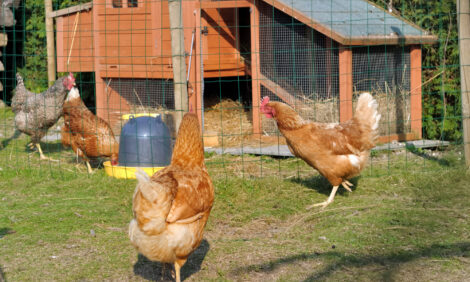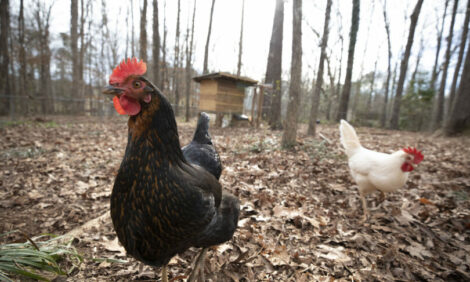



US Poultry Industry Manual - Whole shell eggs
Learn how to manage whole shell eggs in during an animal health emergencyPart of Series:
< Previous Article in Series Next Article in Series >
Editor's Note: The following content is an excerpt from Poultry Industry Manual: The Foreign Animal Disease Preparedness and Response Plan (FAD PReP)/National Animal Health Emergency Management System (NAHEMS) Guidelines which is designed to provide a framework for dealing with an animal health emergency in the United States. Additional content from the manual will be provided as an article series.
Whole Shell Eggs
Prior to processing, confirm that the equipment is clean and ready for operation. Ensure that water levels are correct, wash water is at the target temperature (above 90 °F), chemical supply lines for detergents and sanitizers are connected, concentrations are at supplier recommendations, and the fresh water supply line is open. Sign the operation log, noting the date and time, temperature of wash and rinse, detergent concentration, and chlorine concentration in rinse. After completing all pre-operation checks, introduce eggs into the washing system.
Maintain the operating log, noting the temperature of wash and rinse waters; detergent, chlorine, or other disinfectant concentrations; and condition of wash water for excessive foaming and egg buildup. Systems where detergent is manually added require more frequent monitoring of detergent or chemical strengths than those featuring automated monitoring of concentration. Chlorine in the rinse must be at or above 100 ppm and less than 200 ppm. Make corrections as required to operate the system in established ranges for temperature and chemical concentrations. Note corrective actions in the operating log. At mid-shift, drain the wash water tank and perform mid-shift cleaning. Repeat pre-operational checks before starting operations.
See 7 Code of Federal Regulations (CFR) 56.77(f) (1–15) or 9 CFR 590.515 and 516. Additional procedures and documentation may be required when operating or receiving flocks in a Control Area defined by the State Veterinarian’s office or APHIS veterinary representative.
Clean-in-Place Requirements for Liquid Egg Tankers, Lines, and Silos
The following procedures are recommended minimum steps for cleaning and disinfection (C&D) of plastic, washable, egg-handling materials. Minimal requirements are given to clean egg tankers, lines, and silos in relation to time, temperature, concentration, and flow. Procedures require appropriate system design to wet all surfaces. Prepare the clean-in-place (CIP) system as defined for the plant. Execute the CIP, meeting the minimal time, temperature, concentration, and flow requirements outlined in the tables below.
Table 4. Clean-in-Place Requirements for Liquid Egg Tankers |
||||
Process |
Time |
Temperature |
Concentration |
Flow |
Pre-rinse |
5.0 minutes |
Ambient |
||
Caustic wash |
7.0 minutes |
150˚F |
1.5-2.5% |
70 gal/min |
Rinse* |
3.0 minutes |
Ambient |
||
Sanitizer |
2.0 minutes |
Ambient |
1500-2500 ppm |
|
Table 5. Clean-in-Place Requirements for Liquid Egg Lines |
||||
Process |
Time |
Temperature |
Concentration |
Flow |
Pre-rinse |
5.0 minutes |
Ambient |
||
Caustic wash |
10.0 minutes |
150˚F |
1.5-2.5% |
> 5ft/sec |
Rinse* |
5.0 minutes |
Ambient |
||
Sanitizer |
2.0 minutes |
Ambient |
1500-2500 ppm |
|
* Apply an acid rinse as needed to remove mineral build-up (minimum 5,000ppm). |
||||
Table 6. Clean-in-Place Requirements for Liquid Egg Silos |
||||
Process |
Time |
Temperature |
Concentration |
Flow |
Pre-rinse |
5.0 minutes |
Ambient |
||
Caustic wash |
15.0 minutes |
150˚F |
1.5-2.5% |
70 gal/min |
Rinse* |
5.0 minutes |
Ambient |
||
Sanitizer |
2.0 minutes |
Ambient |
1500-2500 ppm |
|
* Apply an acid rinse as needed to remove mineral build-up (minimum 5,000ppm). |
||||
Liquid Egg Tanker Exterior Wash Procedure
Make sure that all openings on the tanker are closed tightly. Clean the undercarriage and tires with a high-pressure washer and appropriate detergent to remove dirt or ice. Foam the entire exterior of the tanker, undercarriage of the trailer, and tires with a soft, metal-type, general purpose foaming cleaner. Follow the manufacturer recommended procedures for this product. Let foam sit on all areas for 5 to 10 minutes. Rinse with a quaternary ammonium or chlorine sanitizer after foam.
Minimum sanitizer concentration for quaternary sanitizer is 200 ppm (or per manufacturer’s recommendation). Minimum sanitizer concentration for chlorine is 50 ppm. Check the concentration of the sanitizer on every tanker and record the results on the exterior wash certificate. After all areas are rinsed with sanitizer, complete the exterior wash certificate. Give one copy of the exterior wash certificate to the driver and file the other copy with the tanker unloading paperwork.
Egg Shells
Produce, collect, and handle shells consistent with good manufacturing practices. Clean and maintain all transport vehicles following protocols for C&D of exteriors and interiors (and cab interior if drivers are allowed outside of the cab during loading or unloading of the wet shells). Remove all debris and organic material through physical cleaning and high-pressure washing. Wash with an approved detergent and rinse with potable water. Apply an approved disinfectant, following label instructions. Clean the cab interior with approved disinfectants. Document by filling out the dryer log and provide supporting information as needed.
Inedible Liquid Egg
Produce, collect, and handle inedible liquid egg consistent with good manufacturing practices. Maintain inedible egg at temperatures less than 45 °F until pasteurized and dried or otherwise heat-treated. Clean and maintain all process lines, centrifuges, bins, trucks, and dryers following protocols for CIP of liquid process systems, including the interior and exterior of tankers, hand-cleaning where applicable. Clean and disinfect the interiors of trucks transporting inedible eggs in barrels or similar containers following procedures for cleaning interiors of trucks transporting nest run shell eggs.
At the drying facility, pasteurize the inedible liquid egg. For inedible liquid egg with solids less than 25 percent, process with a minimum hold time of 188 seconds at 60 °C (140 °F ). Maintain pasteurized inedible egg under refrigeration until dried and packaged. Maintain dried, inedible egg following good manufacturing process. Applications of inedible egg may include a thermal heating or cooking preparation procedure for feeding to animals. Thermal treatments exceeding 70 °C (158 °F) should be acceptable. Document by filling out the pasteurization log and providing supporting information as needed.
Manure
Manure truck drivers must remain in the truck at the pullet or layer farm and remain in the truck cab during manure loading, removal, and vehicle cleaning and disinfection. Individuals involved in manure loading, collection, removal, or vehicle cleaning should wear dedicated clothing and use dedicated equipment. These activities should be recorded in a logbook with the date, time, and the person’s name. Individuals spreading manure should wear disposable plastic boots (at a minimum) and leave them outside the vehicle. Before entering a personal vehicle and leaving the farm, individuals involved in manure removal should shower (if possible), change clothes and shoes, and clean the interior of their personal vehicles.
Manure-hauling vehicles should be cleaned and disinfected before arriving at the designated location for the first time. At the farm or site entrance and exit, clean and disinfect the undercarriage and tires using a portable sprayer or similar suitable equipment. Unload the manure at the designated dump point. A designated unloading person should be present at the dump site so the driver can remain in the cab. At the end of the working day, if the truck will not be coming back to the same farm or site, it should be cleaned. Remove all visible organic matter with a pressurized sprayer. Thoroughly clean the inside and outside of the vehicle and spreader or trailer with foam or spray detergent and designated brush. Rinse with water.
Mortalities
Each morning, dead chickens should be removed from the cages and from the houses. The goal of carcass disposal is to facilitate decomposition of carcasses and destruction of any pathologic disease agent present while limiting the spread of disease. One method will not fit all circumstances so several carcass disposal options should be considered. Composting is accomplished by placing carcasses and carbon sources such as litter, straw or wood shavings, in simple uninsulated bins and allowing normal decay processes carried out by bacteria and fungi to occur. Additional disposal methods include incineration, on-site burial, burial in public landfills, and rendering.
Reference: "USDA APHIS | FAD Prep Industry Manuals". Aphis.Usda.Gov. 2013. https://www.aphis.usda.gov/aph...
The manual was produced by the Center for Food Security and Public Health, Iowa State University of Science and Technology, College of Veterinary Medicine, in collaboration with the USDA Animal and Plant Health Inspection Service through a cooperative agreement.















